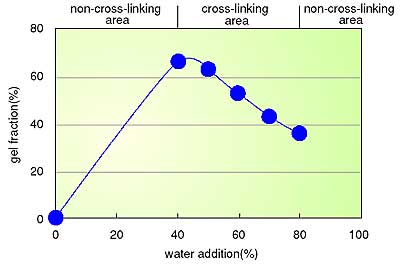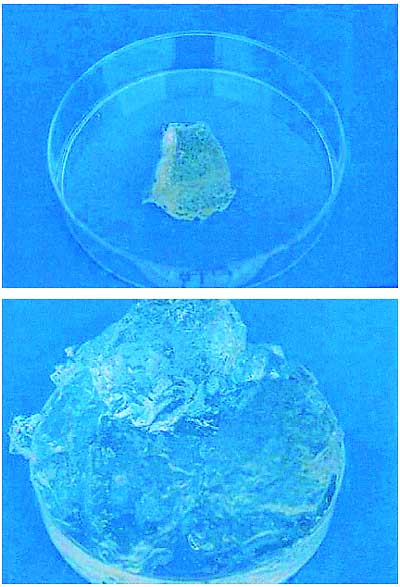9-2 |
Changing Starch into a Tough and Highly Water-Absorbing Gel
|
 |
||
|
 |
||
|
| A devil's tongue is a member of the same natural polymer family (polysaccharide) as starch and cellulose, and is characteristically biodegradable by microorganisms. In a dry state, it is powdery, but it is changed into a so-called "gel" by adsorbing several hundred times its own volume of water. Such a highly water-absorbing property originates from a molecular structure having an affinity for water. Gel will keep a certain shape, but can be easily torn owing to the lack of covalent bonds. If a tough devilŐs-tongue without tearing could be developed, it could be used widely as sanitation goods and as an agricultural material. The usefulness is synergistically enhanced by its biodegradable characteristic. We have studied how to prepare a tough gel from cellulose and starch. After some investigation, we have found that irradiation of starch in a paste state after adding carboxymethylated cellulose and water yields an elastic gel, the molecular chains of which are partially linked, that is, cross-linked. Cellulose was believed not to be cross-linked by radiation. Thus, this could be an epoch-making discovery. Fig. 9-4 illustrates the relation between the percent of added water for the irradiation process and gel fraction. The gel fraction is the percentage of insoluble component due to cross-linking. It is seen that cross-linking is induced most effectively for an added water fraction of about 40%-50%. Cross-linking is stronger than a simple entanglement of molecular chains. Consequently, the cross-linked starch and cellulose cannot be torn and keeps its shape upon pressing. They have elastic properties just like rubber. Such properties enable us to use the gel for sanitation goods and for agricultural materials. Fig. 9-5 shows photographs of the sample just after irradiation (upper) and of the gel after the addition of water (lower). It is seen that the addition of water has increased the volume by several hundred times. Moreover, this process is very simple wherein cellulose or starch kneaded with water was irradiated in polyethylene envelope. We are planning to explore uses for the gel as a highly water-absorbing, elastic, and biodegradable "triple-threat" material for environmental conservation as well as for sanitation and agriculture. |
| Reference F. Yoshii, Biodegradable Gel, Water., 6, 16 (2001) (in Japanese). |
| Select a topic in left column |  |
| Persistent Quest Research Activities 2002 Copyright(c) Japan Atomic Energy Research Institute |